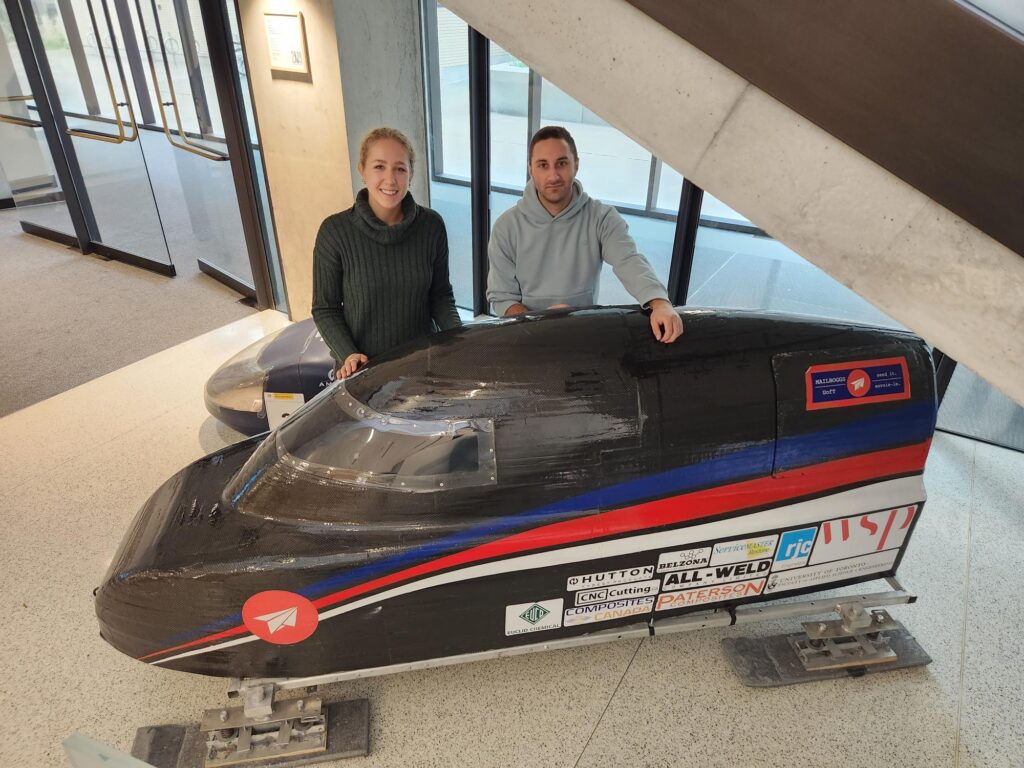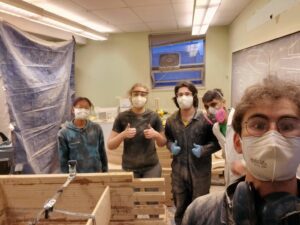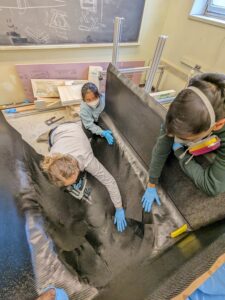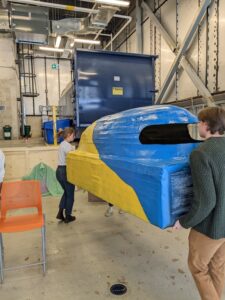
We talked to the U of T Concrete Toboggan Team’s co-captains before they headed out for the annual Great Northern Concrete Toboggan Race (GNCTR) in Kelowna, B.C. this week. Hoping to follow up the success of the last in-person event in 2020 with another win, the team’s leaders share their insight and overall camaraderie the event brings to the multidisciplinary group of student engineers.
Could you introduce yourself?
N – My name is Nathaniel Rzepka. I’m in Civil Engineering in [fourth year], and I’m doing a minor in Environmental Engineering.
L – I’m Lindsey Wells. I’m also a [fourth year] in Chemical Engineering and double minoring in Bioengineering and Business.
How did you get involved with the concrete toboggan team?
N – In my first year, I walked around the Engineering Club’s fair, looking for one of the concrete teams, because I’m a Civil student, and I wanted to find something related to the program. I came across the toboggan team and signed up for their mailing list. At the first team meeting of the year, I got hooked on what I saw and have stuck with it ever since. I’ve been with the team since my first year – I was a general member for one year, then a concrete lead for my second year. In the third year, I took a year off from my PEY Co-op and now I’m back as co–captain.
L – I heard about toboggan during my first year at the club’s fair. I had the misconception that this built was made from all concrete. I’m in Chemical Engineering, so I thought it would not work for me. I didn’t join until my second year. When I heard from Nathan and some of my other friends as well – toboggan was really fun, so I got involved later in the year. We started doing carbon fibre layups since I’d had some experience with composites. I got hooked up with the team and went to a competition that year. I just loved the social aspect of the concrete toboggan team, as well as the technical side. We have a kind of unique environment in our team that you don’t necessarily get with other ones, which I really enjoy. The year, in my third year, I was a sponsorship lead and then last year, I was a superstructure lead. This year I’m back as a team co-captain.

What is the concrete toboggan team all about?
N- Toboggan is a multidisciplinary design team. We have students from almost every discipline, even in the lead and exact teams. Every year we build a toboggan which looks more like the bobsled you see at the Olympics. We build this thing from scratch entirely, and then we take it out to a competition called Great Northern Concrete Toboggan Race, and we race it against other schools from across Canada and some from the US.
L – The only concrete part of the toboggan is the skis. So we have concrete skis, fully functioning steering and braking systems, and a superstructure that we typically make out of carbon fibre. It doesn’t look at all like a typical toboggan.
N – Yes, and it holds five riders, so it’s pretty big.
L – GNCTR is the largest student-run engineering competition in Canada. The competition itself is kind of unique in that it has a spiritual act as well as a technical design aspect. The technical design is designing, building and racing the toboggan. Then there’s a spirit side – an exhibition where people from the industry and other teams come, and we got a lot of networking through that. A technical exhibition is based on a toboggan theme for the year. We make costumes and design patches, which encourages communication between different engineering schools. You get to meet so many people – that’s the unique part of GMCR. I love meeting everyone from other teams and having personal interactions. Typical design teams are very competitive versus the feeling of camaraderie you get at GNCTR.
N – One of the mottos of the competition is “We are all best friends,” which I think really reflects the kind of atmosphere we strive for as an engineering community across Canada.
It’s actually unusual for a competition to have such a motto.
L – It’s really nice. In all the competitions, things can obviously go wrong. In 2020 we ended up winning the competition at the actual race – the king of the hill. It’s a one-on-one race against another school, and whoever goes faster stays, and another team is out. Things break a lot. That year at one point, we had too much force put on the chassis, so all of our skis fell off, so we had to fix it last minute. All these other teams are so helpful!
N – The most memorable thing from that whole scenario was when we got spare wood from another school. I don’t know any other competition where another school you compete against would give materials to help you get back on your feet.
So, the last competition was in 2020. Did anything change for you this year?
L – This year, we are back in person. For the past two years, we have been online. We still had it, and we’ve been designing everything; we just weren’t allowed to build stuff in person because of regulations.
N- This year, we’re back to building a physical toboggan, and we’re going to race in Kelowna, B.C.
How do your team meetings look like now, and how does it all work?

L – Since we have the spirit and the design sides, we separated our meetings to avoid wasting people’s time. As of now, for the design team, we have weekly meetings and work sessions on Sundays to get everyone together and work. We also have meetings on Monday nights, when it’s necessary to go over deadlines, deliverables and technical reports. On the spirit side, we have meetings and brainstorming sessions, and we have a lead on our team who takes care of it.
N – Concrete toboggan is an interesting design challenge. Many other student design teams here have real-world application projects, but we’re building a concrete toboggan that doesn’t exist in real life, other than this competition. It gives engineers an opportunity to imagine whatever they want and then design and see what comes to fruition. On top of that, we build the entire thing from the ground every year by ourselves. Effectively, it gives students a great opportunity to learn how to use different tools and work with different materials they probably wouldn’t get to work with otherwise. The team gets to work with concrete, steel, wood, and carbon fibre – all in one sitting.
L – To expand on that, I find concrete toboggan an interesting concept, as it also creates a more difficult design process compared to other projects. You can’t go online and see how to do this. You have to combine different ideas to make it work.


And you mentioned the workshops – you organized them yourself?
N – Yes. One thing we pride ourselves on is – our new members don’t need to come in knowing anything. They need an “I want to learn” mindset, and the team leads are open to teaching new members everything they need to know about using materials and how to use them safely.
L- We teach people how to safely use saws, drills, composites and modelling software when it works in with building process. Our workshops are not necessarily scheduled. We organize them when our design process needs that, so our members have a hands-on experience of learning something, instead of waiting weeks and months to apply their knowledge. We ask our general members if they are interested in a particular workshop or have a one-on-one with a lead and go through things. From the manufacturing side of things – carbon fibre is an extremely expensive resource, so most students in schools don’t get a chance to work with it, and a lot of people haven’t ever actually touched it or held it. So being able to have workshops and learn those hands-on skills the way you would in the industry is unique. As an engineer, even if you don’t necessarily want to build something, you need to understand the limitations of manufacturing. That is something you can get only if you are actually building something yourself.
How did you come up with the theme?
N – It’s a long process of kind of just tossing the ideas and just seeing what sticks. We try to stay away from things that have been done in the past, not only by ourselves but by other schools. One of the things that makes a great theme is recognizability. Back in 2020, we were Mail Toboggan, so all team members were wearing Canada Post-inspired costumes, and a lot of schools recognize that.
Did you face any difficulties during this year’s build?

N – We had a lot of timeline-related issues, but we overcame all these. Putting heads down and getting the work done, along with a lot of long nights in various build spaces doing work. The whole team came together and pushed through it as a collective.
L – We had some of these delays this year, because we haven’t had an in-person competition in two years. How to build a toboggan isn’t really something anyone knows, so we had some delays with passing on knowledge and learning from former members who had already graduated, and some knowledge was lost. As Nathan said, it took us coming together and being a very engaged team to overcome everything.
Do you have a lot of new members this year?
N – Yes, we have six brand-brand new members, but only seven of us have been to the competition in-person in 2020. We also have a young lead team this year. All the design leads are in their second year, which in comparison to 2020, is very different as I was the only second-year lead everyone else was either third or higher. So it brings a significant shift in the team dynamic and the way the team works because we are in different stages of our academic careers.
L – It’s fascinating as people came without a set idea of what concrete toboggan is supposed to be. It added a lot of value to the team. We are so excited to be captains this year and to see our new members experience all that work and what GNCTR is really all about.
What is happening this week?

L – We fly out right and early on Wednesday morning, get to Kelowna at 9:00 a.m. and then we have the first day of our competition. We check in at the hotel and start off with meeting other people and an opening ceremony in the evening. On Thursday, there is a Competitor Interaction Day where everybody on our team gets separated into different groups. So essentially, there are 24 team members on each team, and the event organizers arrange around 24 groups. Every team member joins a group with entirely new people to meet and interact with other participants. On Friday is our technical exhibit day where you go around and see everybody else’s designs. One gets a good introduction to everyone’s different themes. Saturday is the exciting day – race day on the big White Mountain in Kelowna.
N – It’s a tubing hill, so it’s much safer than a ski hill. It’s not as steep as a ski hill. There we will have a speed, braking, and slalom race and then a King of the Hill, which is a head-to-head drag race, and if you win, you move on to the next round and keep going until there’s one school left.
L – After that is a closing ceremony that night, and we head out home on Sunday.
Good luck!